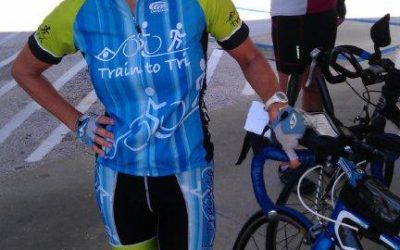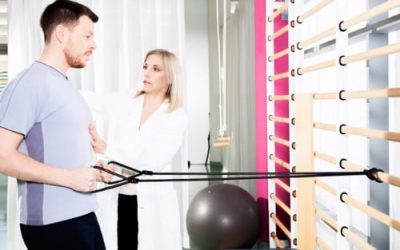There are many benefits of exercise for kids with CMT. I spoke with Dr. Robert Chetlin, Associate Professor, Department of Human Performance and Department of Neurology at the West Virginia University School of Medicine and he has the following advice:
“Children with CMT should be active for a variety of reasons. If we can intervene when a patient with CMT is at the highest level of strength and function, that patient will achieve the highest quality of life as an adult. Also, we know when children are inactive they will go into adulthood with a much greater chance of developing coronary heart disease, obesity, high blood pressure and high cholesterol. Exercise affects a person’s overall health.”
We know that CMT damages the sensory and motor nerves that run from the arms and legs to the spinal cord and brain, ultimately causing muscles in the feet, legs and hands to lose strength. Specifically, how does exercise benefit CMT patients?
“Our research has demonstrated that those patients who engage in a program of resistance training, for at least 12 weeks, experience beneficial changes in strength and function; certain muscle fiber types also increase in size – a beneficial effect called hypertrophy. We have also found that chronic (i.e. one year) resistance and endurance exercise not only improves strength, but also sensory function, as indicated by measures of balance and postural weight distribution.”
Can exercise reverse the effects of CMT?
“The clinical literature indicates that regular exercise may slow the progression of the disease; there is no evidence that exercise can actually reverse disease progression.”
Is exercise painful for children with CMT?
“Many patients do not experience pain during activity or exercise, but in severe cases of CMT, patients may experience pain. If a person with CMT feels pain during exercise that is beyond normal fatigue, he/she should consult with a doctor or physical therapist before continuing with that part of the exercise routine.”
What about CMT patients who have difficulty breathing?
“In severe cases of CMT, the phrenic nerve (the nerve that innervates the diaphragm) may be affected. However, there are many muscles in the trunk and abdomen that also participate in ventilation (the work of breathing). If exercise targets these muscles, then this may compensate, in part, for dysfunction of the diaphragm.”
Can you give some examples of resistance training and aerobic exercise that would be beneficial?
“We follow the art of exercise prescription which dictates that the science of exercise be used to formulate an exercise/activity program for the individual. By identifying strengths and weaknesses, including contraindications, we devise a program of exercise tailored to the patient’s specific needs, [such as] resistance training using machines for leg presses, curls and extensions, stationery rowers, bikes, recumbent bikes and elliptical trainers for aerobic exercise.”
How do you differentiate between exercise and activity?
“Exercise is structured and supervised for positioning, breathing and proper lifting of weights [as in a gym] with a goal in mind. Activity includes a psychological/social element such as playing games during physical education.”
Can you give us some tips for schools in terms of adaptive physical education, field day or recess?
“The most important thing is for kids to be kids and to enjoy play. A child having problems with ambulation can have an emphasis on upper body activities like throwing, catching, races where players push on carts. Games should be tweaked to be fun and inclusive of those with CMT. Teams of two can have the child with CMT swing a bat while the other child runs bases. And relays can be standing still with items being passed down the line. It is important to inform and update PE teachers on how best to incorporate children with CMT. “
How much exercise should a child get on a daily basis?
“The American College of Sports Medicine recommends 20-30 minutes of activity per day.”
Do you have any suggestions for working that into our children’s hectic schedules?
“It doesn’t have to be 30 consecutive minutes each day. It can be broken up into 10 or 15 minute sessions at a manageable level of intensity. The biggest challenge is making it fun. You have to find types of action that are meaningful, effective and enjoyable to the patient. Exercise games, videos, Wii and Dance Revolution are great choices.”
What suggestions do you have for parents of children or teens who refuse to participate in activity?
“You can’t force people to do what they don’t want to do. You can say, ‘you have these problems and we can help you’ but the person has to be willing. Education is important. If you expose the child to a small element of exercise and show them the improvement, it can be cathartic. It is human nature to want to relax, but life requires balance. Sometimes it helps to say just try it for a month. Exercise helps prevent disuse atrophy – wasted muscles – it is much more dramatic in patients with CMT.”
Thank you for explaining the importance of exercise in childhood for CMT patients. You have given some wonderful ideas to make it enjoyable. But I don’t think you would necessarily call it an easy fix.
“Not an easy fix, but the RIGHT fix!”






The great benefit of exercise for kids is a lower blood pressure and an improvement of the child’s cholesterol profile.
Kids can develop stronger bone structure and muscle structure.
They help improve team building activities for kids.
Exercises and workouts aids in the development of social skills.
Here is a great article that tells you about benefits of exercises for kids along with different workouts: Enjoy the article: http://www.momjunction.com/articles/best-benefits-excercise-kids_0075233/